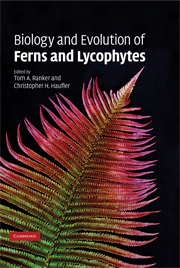Book contents
- Frontmatter
- Contents
- List of contributors
- Preface
- Acknowledgments
- Part I Development and morphogenesis
- Part II Genetics and reproduction
- Part III Ecology
- Part IV Systematics and evolutionary biology
- 12 Species and speciation
- 13 Phylogeny and evolution of ferns: a paleontological perspective
- 14 Diversity, biogeography, and floristics
- 15 Fern phylogeny
- 16 Fern classification
- Index
- References
12 - Species and speciation
Published online by Cambridge University Press: 11 August 2009
- Frontmatter
- Contents
- List of contributors
- Preface
- Acknowledgments
- Part I Development and morphogenesis
- Part II Genetics and reproduction
- Part III Ecology
- Part IV Systematics and evolutionary biology
- 12 Species and speciation
- 13 Phylogeny and evolution of ferns: a paleontological perspective
- 14 Diversity, biogeography, and floristics
- 15 Fern phylogeny
- 16 Fern classification
- Index
- References
Summary
Introduction
Two of the most basic elements of evolutionary biology, species and speciation, are also among the most enigmatic and consistently debated. Systematists seem to have a love/hate relationship with both of these topics, and have devoted literally thousands of pages over the past century and a half to exploring what species are and how they originate. In this chapter, general aspects and contemporary perspectives on species and speciation in ferns and lycophytes will be discussed and interpreted.
Are species real or imagined?
When studying biodiversity, a fundamental question that emerges is, “Do species exist?” Why is the variety of life on earth subdivided into a set of discontinuous and distinct groups rather than existing as a seamless series of intergrading populations? Although this appears to be a central question for biologists to answer, prominent authorities consider it to be “one of the most intriguing unsolved problems of evolutionary biology” (Coyne and Orr, 2004). How do the clearly observable distinctions between the groups we label species arise, and what maintains separate ancestor–descendant lineages through time and space? According to some scientists (including Charles Darwin), species may be arbitrary human constructs erected for our convenience (see also Raven, 1976; Mishler and Donoghue, 1982). On the other hand, we can all detect and give names to non-overlapping distinctions among natural populations of organisms.
- Type
- Chapter
- Information
- Biology and Evolution of Ferns and Lycophytes , pp. 303 - 331Publisher: Cambridge University PressPrint publication year: 2008
References
- 14
- Cited by



